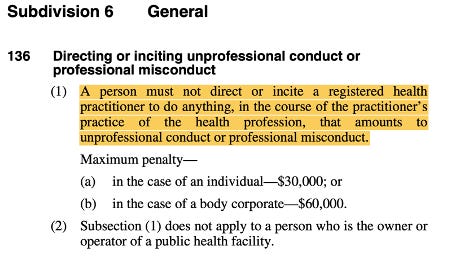AHPRA’s gag order is a house of cards
Australian health regulator has no legal basis for censorship of doctors
On 9 March 2021, AHPRA and the National Boards, which regulate the health professions in Australia, issued a “Joint Position Statement” which effectively gagged doctors and other health practitioners from talking about the risks of the COVID-19 vaccines:
So, if a doctor made a statement which was critical of the vaccines, they could be suspended. Many were, and still are. Others have their licences back, with conditions referencing the position statement.
AHPRA has since decommissioned its 9 March 2021 position statement. But the dangerous precedent of AHPRA and the Medical Boards telling doctors and other health professionals what they can and can’t say, has been set. And the position statement’s influence lives on.
In this article, I examine whether there was ever any legal basis for this gag order – and conclude there wasn’t.
Health professionals are regulated by the so-called “National Law”. There are some provisions in the National Law which give AHPRA the power to issue documents are relevant for determining what is appropriate professional conduct:
Section 38 of the National Law requires AHPRA to issue registration standards
Under Section 39 AHPRA can also issue codes and guidelines.
Section 41 provides that approved registration standards, and codes and guidelines, are admissible in disciplinary proceedings against health practitioners as evidence of what constitutes appropriate professional conduct or practice for the health profession:
41. Use of registration standards, codes or guidelines in disciplinary proceedings
An approved registration standard for a health profession, or a code or guideline approved by a National Board, is admissible in proceedings under this Law or a law of a co-regulatory jurisdiction against a health practitioner registered in a health profession for which the Board is established as evidence of what constitutes appropriate professional conduct or practice for the health profession.
Here’s the rub: the position statement was none of those things!
The preamble in the statement itself distinguishes it from codes and guidelines, as highlighted below:
And AHPRA and the National Boards didn’t list it on their website along with other codes and guidelines, even before it was archived in Dec 2023. (Take a look - you won’t find it: the website as it was in 2021 is here; and the current website is here.)
Given the joint position statement was not a registration standard, a code, or a guideline, it had no status under the National Law. It is not admissible as evidence of what constitutes appropriate professional conduct, because it is not a type of document which is recognised by section 41 of the National Law a being admissible for disciplinary proceedings. The 9 March 2021 “Joint Position Statement” is effectively just a media release.
Perhaps we can find a legislative basis for the gag order elsewhere?
Let’s start with the objectives of the National Law, which include:
“to provide for the protection of the public by ensuring that only health practitioners who are suitably trained and qualified to practise in a competent and ethical manner are registered”.
Let’s call that the “safety objective”. (There are also a number of other objectives such as facilitating workforce mobility across Australia, high quality education, assessment of overseas-trained practitioners, and promoting access to health services and a thriving and innovative health workforce.)
There are also some guiding principles talk about protection of the public and public confidence in the safety of services provided by health practitioners:
3A Guiding principles
(1) The main guiding principle of the national registration and accreditation scheme is that the following are paramount—
(a) protection of the public;
(b) public confidence in the safety of services provided by registered health practitioners and students.
…but these are guiding principles for administering the Act in order to achieve the Act’s objectives – not blank cheques for the medical boards to do whatever they think will ‘protect the public’ (such as sanctioning doctors for expressing legitimate concerns).
AHPRA and the Boards need us to believe that their joint position statement is consistent with the safety objective of the National Law. If it isn’t, then there would be no legal basis for it.
The position statement effectively prevents doctors from discussing the safety risks of vaccines (if they do, they might lose their job). How is this ensuring that only suitably trained and qualified doctors are practising medicine competently and ethically?
In order to come within the safety objective of the Act, the rationale for the position statement would have to be that it is unsafe for doctors to explain to patients the safety risks.
That would be incitement to breach the code of ethics for which they can be prosecuted under s136 of the National Law:
Class action, anyone?
(Editorial note: when writing this article I couldn’t bring myself to capitalise “position statement”: as the article explains, the document is nothing more than a media release, which the Medical Boards are pretending is relevant for defining what constitutes unprofessional conduct or misconduct.
Similarly, I shouldn’t really have called the national law the “National Law” because it’s not a law – it’s a series of Acts passed in the various jurisdictions which happen to largely line up with each other - but that’s a story for another day.)






UNITE WITH GOD AND LIKE MINDED BROTHERS AND SISTERS AGAINST CORRUPT TREASONOUS MURDERERS
Pure evil